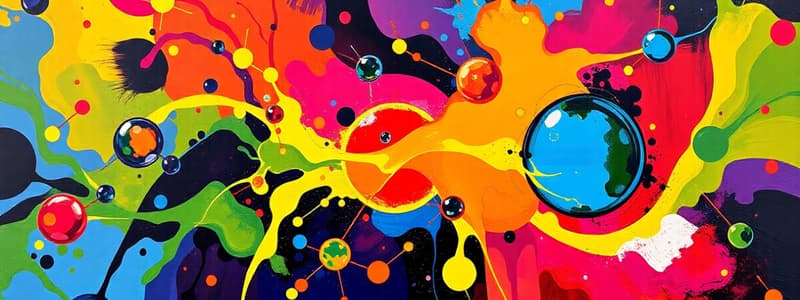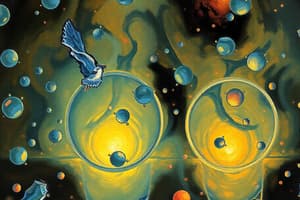Podcast
Questions and Answers
If a substance donates electrons during a chemical reaction, what type of reaction is occurring and what happens to the charge of the substance?
If a substance donates electrons during a chemical reaction, what type of reaction is occurring and what happens to the charge of the substance?
- Reduction; the charge becomes more positive.
- Oxidation; the charge becomes more negative.
- Reduction; the charge becomes more negative.
- Oxidation; the charge becomes more positive. (correct)
Which of the following is an example of a synthesis reaction?
Which of the following is an example of a synthesis reaction?
- The dissolving of salt in water, creating ions.
- The digestion of fats into fatty acids and glycerol using water.
- The formation of a protein from individual amino acids with the removal of water. (correct)
- The breakdown of glucose into carbon dioxide and water.
A solution contains a high concentration of ions that release hydrogen ions (H+) when dissolved in water. How would you classify this solution?
A solution contains a high concentration of ions that release hydrogen ions (H+) when dissolved in water. How would you classify this solution?
- Acidic. (correct)
- Basic.
- Hydrophobic.
- A salt.
Consider a scenario where a large molecule is broken down into smaller components through the addition of water. What type of reaction is this, and is it typically endergonic or exergonic?
Consider a scenario where a large molecule is broken down into smaller components through the addition of water. What type of reaction is this, and is it typically endergonic or exergonic?
If a molecule is described as hydrophobic, which characteristic best describes it?
If a molecule is described as hydrophobic, which characteristic best describes it?
Flashcards
Matter
Matter
Anything that occupies space and has mass; can be solid, liquid, or gas.
Chemical Compound
Chemical Compound
Substances formed when elements combine chemically.
Atom
Atom
The smallest particle of an element that retains the properties of that element.
Ions
Ions
Signup and view all the flashcards
Redox Reaction
Redox Reaction
Signup and view all the flashcards
Study Notes
- Matter occupies space, has mass, and exists as a solid, liquid, or gas. It is composed of elements.
- Chemical compounds consist of elements in combination.
- Atoms are the smallest particles of an element.
- The atomic nucleus contains protons and neutrons.
- Protons are positively charged particles.
- Neutrons are particles without charge.
- Electrons are negatively charged particles.
- Ions are electrically charged atoms, molecules, or particles.
- Cations are positive ions formed by electron loss.
- Anions are negative ions formed by electron gain.
- An electrolyte contains free ions in a solvent.
Chemical Reactions
- Synthesis (dehydration synthesis) forms a larger molecule from smaller ones through the removal of water and requires energy (endergonic).
- Hydrolysis breaks down large molecules, requires water, and gives off energy (exergonic).
- Redox (reduction-oxidation) involves the simultaneous transfer of electrons.
- Reduction is the gain of electrons.
- Oxidation is the loss of electrons.
Compounds
- Hydrophilic compounds are water-soluble.
- Hydrophobic compounds are insoluble in water.
Inorganic Compounds
- Inorganic compounds generally do not contain carbon, with the exception of carbon monoxide (CO) and carbon dioxide (CO2).
- Examples include acids, bases, salts, and water. Salts dissolve in water and do not release hydrogen or hydroxyl ions.
Organic Compounds
- Organic compounds contain both carbon and hydrogen.
Studying That Suits You
Use AI to generate personalized quizzes and flashcards to suit your learning preferences.




